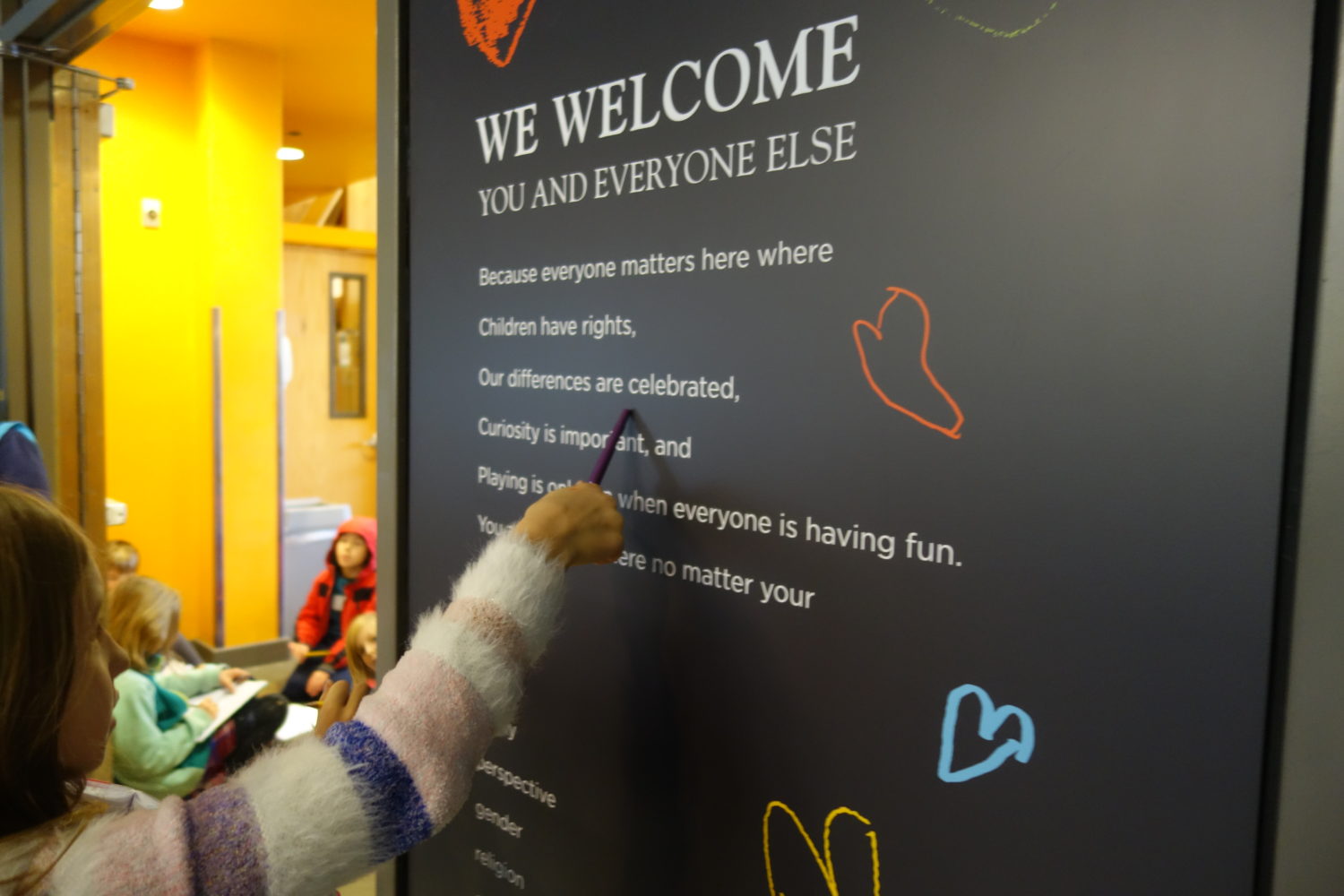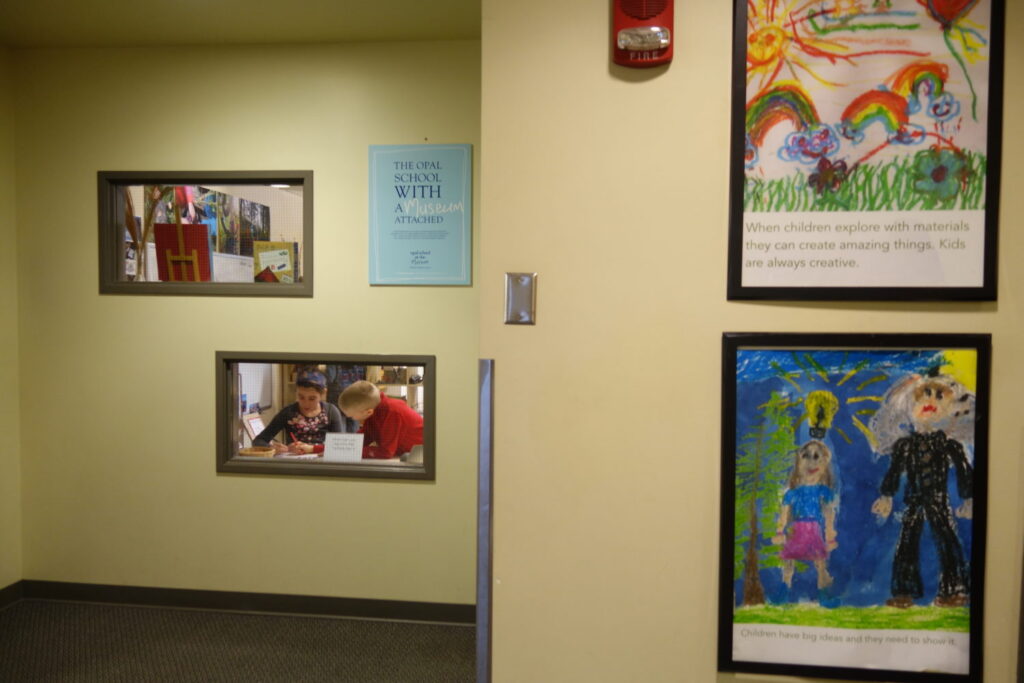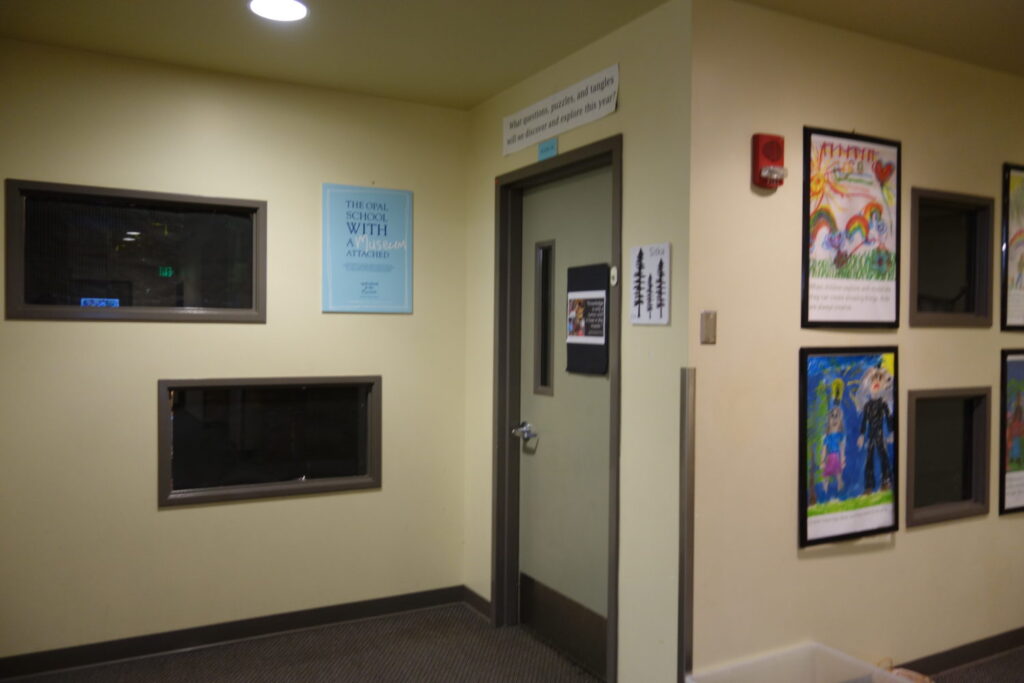Windows into Perspective-Taking

The Sitka Community of 8- and 9-year-olds is housed in an Opal School classroom located on the main floor of Portland Children’s Museum. Museum guests often peek through the windows as they pass by.
One day, as a few students were working at a small table underneath a museum-facing window, they seemed to tire of the young visitors staring at them. They taped a handwritten sign to the window that said, “Leave.”

We teachers wondered:
What was the intention behind the creation of the sign?
What messages were the children hoping to communicate?
Were the children aware of the possible impact that a sign like that could cause?
What was their understanding of how others would perceive their action?
We began a group dialog asking, What does it feel like to have windows that look into our classroom?
Aurora: It feels all right but not totally okay because when people look in it may feel distracting.
Allan: I don’t like it. I like looking out, but I don’t people looking in.
Alexa: I like them for looking out. I like the outside windows; they are perfectly okay. But the other windows are distracting when I am working there. People are peeking in the lower windows when I am working there.
Michael: I like to work there, and it is distracting. I get carried down the road, and it is hard to get back.
What we heard from the dialogue is that the children perceived the windows as a distraction to their work. What we did not hear was the children thinking about the possible perspectives of others that might have an opinion about this situation.
As an invitation to imagine different perspectives, we played with the thinking protocol, True For Who. This routine helps people imagine how an issue can look from different points of view around a claim.
In this situation, the claim was:
It is okay for Portland Children’s Museum visitors to look through the windows of the Sitka Classroom during school hours.
Some possible stakeholders that the children brainstormed were:
- Opal students
- Museum visitors – parents and the children
- People who built this building
- Museum staff
- Head of Exhibits
- Executive Director of the Museum Director of facilities
- Opal Office Manager
- Opal teachers
- Opal office
- Opal parents
- Teacher Visitors
Polly chose to think about this claim through the perspective of Ruth, Portland Children’s Museum’s Executive Director.
I’m Ruth. I wish I could help these Sitka students, but I’m too busy. I think it is not okay (for visitors to look through the windows) because I want them (Sitka students) to do their best. I would change my mind if they were not getting bothered.
Nick chose a toddler visiting the museum:
I’m a kid, and I feel like it is fair for me to knock on the windows for me to have fun because it is all about me. It’s fun to look at people’s work, and it is also fun to be distracting and have people look at me!
In both examples, we were not seeing the children stretch themselves. It seemed like thinking how others viewed this claim was a challenging task for them. They felt one way about the claim – and they were unable to put those opinions and assumptions aside to understand what others could possibly feel and think about the claim.
As we unpacked the experience, the children were able to reflect and challenge each other towards understanding another’s perspective.
Nick: They (the museum guests) come to play, but they don’t know it can be distracting.
Skye: I just realized that when we go downstairs, we look in Dogwood’s (learning community of first- and second-graders) window when we are on the ramp.
Nick: We do it because we are curious. We want to say hi and want to know what they are doing
Alexa: If I was a little kid, I would be soooo curious….
It was here where we saw the children slowly being able to consider the reason why museum guests look into the classroom – their intentions and their unawareness of the impact their actions could be causing to children inside. They were able to consider this perspective because they remembered that they had also been on the other side of a window curiously looking in.
Reflecting on this, we wondered how we could play with the children, as well as how we could play with big ideas such as perspective-taking, intention versus impact, welcoming, and belonging.

The next day, the children found their classroom re-designed as a response to what we heard them asking for in our prior conversations. All the windows were blacked out. The tone in the room suddenly differed from the day before.
Tyler: Why are all the windows blocked?
Fred: Remember, no distractions…
Kevin: But I’m feeling frustrated….
Allan: But I liked those windows more than I wanted them gone. I liked it more before than I like it now. It feels like nobody allowed to distract you. Being distracted is kind of welcoming. Normally they are not there for a long time. People being distracted wasn’t that bad. Having those windows felt more welcoming.
Alexa. I noticed that those windows taught me how to control myself.
Polly: I feel like it’s abandoned like no one is here. It is unwelcoming and kind of mean like we are shutting them out. Like, “No, you can’t help us, and we want to learn by herself.” The people are not trying to hurt us.
Fred: I agree with Penny; it feels like this place is abandoned. It looks like the window is still there, but abandoned.
Tyler: I actually disagree. I like the windows black. I’m a night person. I prefer when it is dark. Those were such a distraction!
Michael: I kind of feel like it is saying to the people out in the museum this is only meant for these people and if you are not these people you can’t. If I was someone in the museum, I would feel sad.
John: I like the covering up the windows…I feel calm, and I could work. When you walk into this room, there is a sign that says it is a school, so they might understand why the windows are blocked.
Nick: The little kids are too interested in us to look up.
Carlie: I think we should open up one window.
Allan: I want these to be open.
Carlie: When windows are opened, people would knock on them, and people waved, and that made them feel welcomed
Syd: I like it when they are shut because it is calming but it doesn’t feel welcomed. Maybe we can put more welcoming colors.
John: When I look back it feels like the room is out in space…
The change invited the children to consider how blocking the view into our classroom to the public could be perceived. They were worried that the “people might feel unwelcomed…and sad and confused.” To begin to move forward with their thinking, the children needed to know “about what the museum guests want and what they like so they can enjoy, but we can still learn.”
The black paper came down promptly, but we were able to use the experience to reflect further on our role of being in a classroom located in a public space. This unplanned lesson around welcoming, belonging, and perspective-taking offered us many opportunities to practice several thinking routines that invited the children to push and dig deeper into their ideas, thoughts, theories, and understanding. Using the thinking protocol I used to think…Now I think…, we were able to uncover the children’s reflection and how living in, working on and playing with the situation altered their thinking and understanding.
I used to think the windows were not a good thinking thing for me. Now I think they give me more light and imagination for my stories. The things outside, like the paintings, can give me great ideas for my stories and can help me with my pictures and looking out make me feel peaceful. What we can do next is to make the visitors feel welcomed and joy and grateful.
Carlie
I used to think covering up the windows would help a lot more. Now I think it would feel mean to the visitors outside. What made that shift is seeing the windows actually covered. It felt like the whole world was dimly lit.
Michael
This experience led us to use the phrase “perspective-taking” a lot – and the children seemed to develop a strong understanding of what it meant. They could see it in books and other spaces where it was outside of themselves. When it hit them personally, that’s when the once abstract tangle became real. It’s one thing to understand it and talk about it cognitively. It’s a wholly different moment when you are asked to confront something and see it as real. That’s how you can work through that knot. They were stuck on the hill of not wanting to give up their ideas. This situation brought their ideas to them. We will continue to invite the children to use this story as a lens to look through as they explore how we can consider and welcome the perspective of others.
